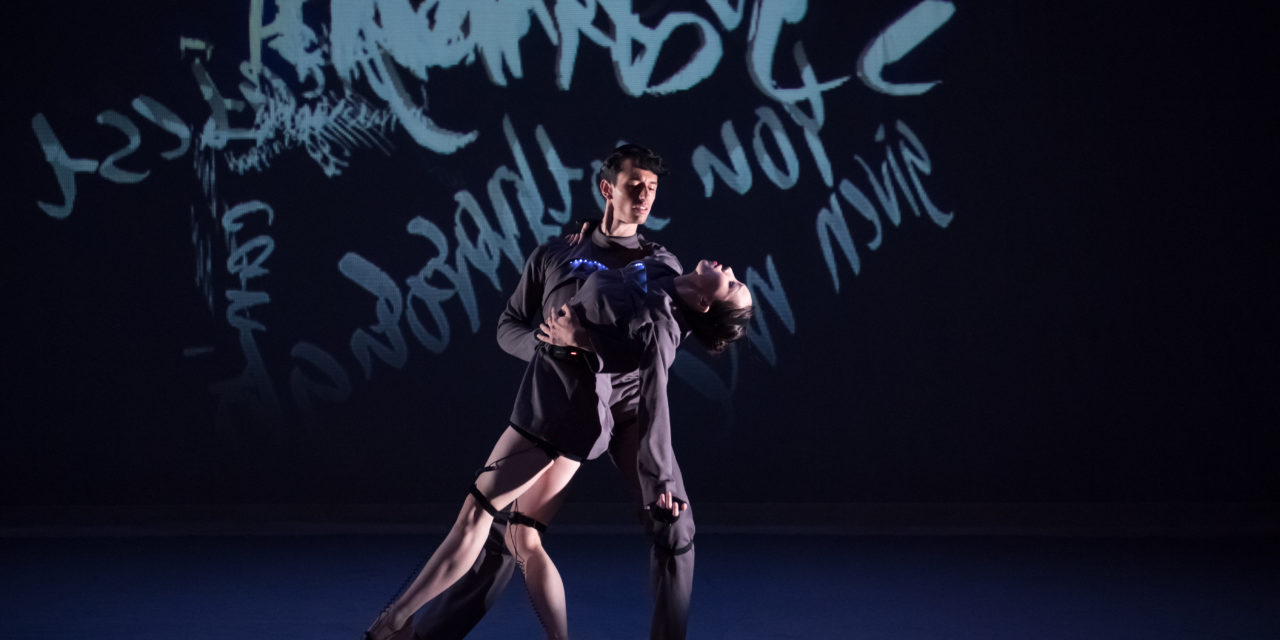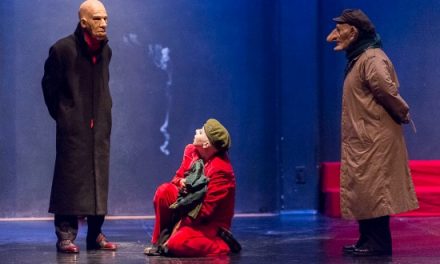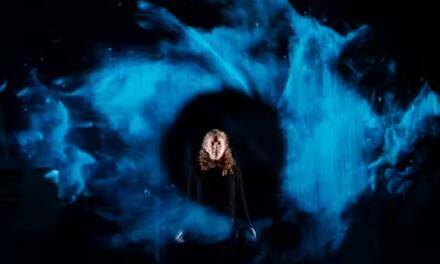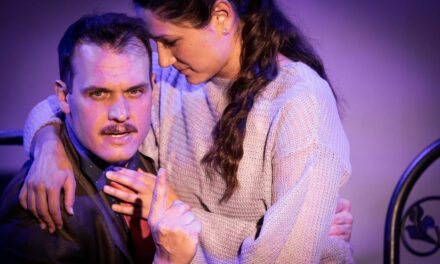Hong Kong Ballet’s Hong Kong Cool showcases seven short pieces of new ballet works by dancers in the company who strive to be choreographers. Hong Kong Ballet has already been doing choreographers’ showcases for the last two seasons. I was pleased by last year’s showcase with some really good pieces, showing the choreographers not only focusing on the movements but also considering themselves as directors who enhanced a vision to each of their pieces.
This time, Hong Kong Ballet took a leap and started to let the choreographers do crossovers with other artists of different disciplines. As a joint production between Hong Kong Ballet, West Kowloon Cultural District and Hong Kong Art School, Hong Kong Cool gives a playground for strangers to play together. These people include musicians, visual artists, painters, a software designer of motion capture, a ceramic artist, and a fashion designer.
I always think that doing experiments is the fundamental drive for any production to be matured through the test of time. It is also an important element for artists to grow as they can always learn from experiments due to its research nature. However, experiments should be a device to develop new works, which means those works still need to be under certain criteria of theories and techniques, especially when these experiments require other disciplines of art.
No doubt, Hong Kong Cool is an important step for dancers/choreographers in Hong Kong Ballet to think outside the box to break forms from the ballet canon. However, it is also much more challenging for all parties to make their pieces successful because these pieces are no longer linear directed. As crossovers, these pieces should be able to shed light on both or more parties contributed, and each of them should be able to deliver an elaborate idea through the merges of these different artistic disciplines.
Hong Kong Cool, in the end, is halfway home. It is unfortunate that most of them are lost in the middle.
The reason why I say that is because I feel that some of the pieces are still focusing on the dance while the other crossover elements have reduced to just a supportive element of the piece. For example, Forrest Rain Oliveros’ Mellifluous incorporates with the blue painting by painter Chloe Ho, projected at the back of the stage. It is a regulated neo-classical piece with Vivaldi’s Violin Concerto as the music of the dance. Ho’s painting also becomes the print of the dancers’ costumes. I kept asking myself, “It is a fine piece, but then, is there any difference if it is another painter’s painting? Why this piece has to be a crossover with this particular painter? If the dancers are wearing Pollock, it can still work.”
I wonder how much time did the choreographers and artists have to communicate and work with each other in order to develop their works in a sense of “total works.” How much sensitivity did the choreographers have towards the other art disciplines in order to develop their pieces without using the other disciplines as just designs?
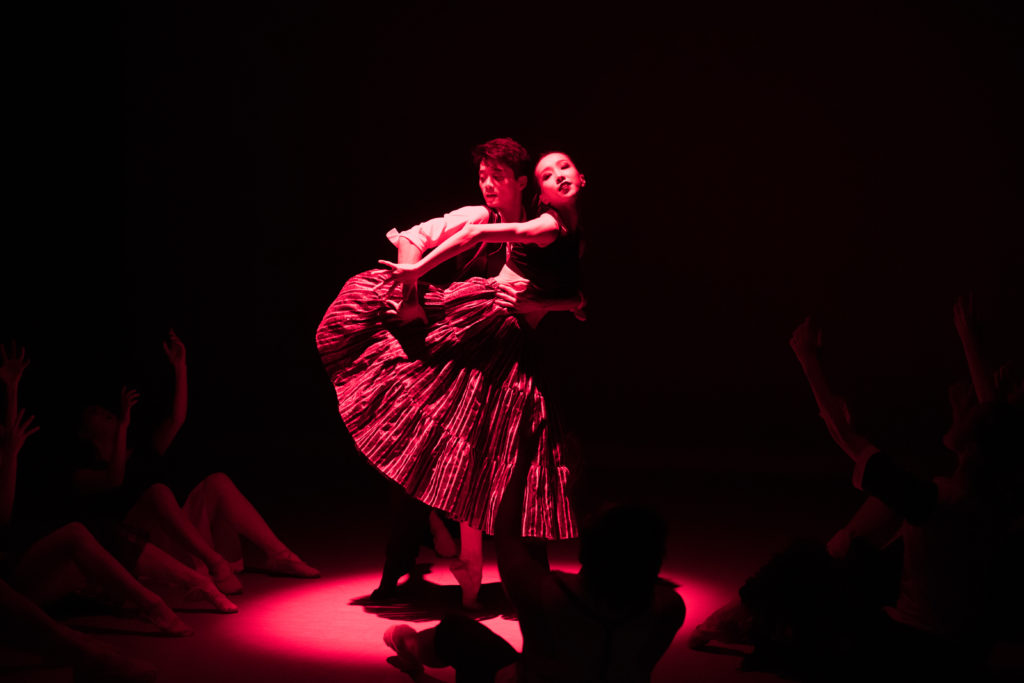
Missing Out Photo Credit: Conrad Dy-Liacco
I can see that this is a huge problem in Jiabo Li and Chaoya Ho’s Empty Awakening which is a crossover with ceramic artist Rachel Cheung and composer Chin Hung Tsui. It is a short psychological piece about the Monkey King in the Chinese classic novel Journey To The West. It is still fine to have a short piece that is more narrative, but if so, then where is the experimental part? The choreography is legit and well danced, but the aesthetic does not lift up to it, leading me not to feel anything emotionally but boredom. Cheung’s ceramic work is only there to cover the monk’s body like a statue, and Tsui’s atonal music is not cohesive to Li and Ho’s vision.
Same as Lin Li’s Missing Out which to me is probably the hardest piece to develop among all, as it is a crossover between ballet and fashion. Li’s The Bow in last year’s choreographers’ showcase was a well-rounded abstract piece that spoke volume. I did have high hopes for his work this year, and alas, how I was disappointed with Missing Out. Chin Yeung’s fashion designs are drowned by a narrative ballet with a clichéd libretto of a love triangle, which reduces Yeung’s designs as “costumes.” There is only one piece of couture dress that really stands out as a fashion piece. These moments do not last long, thus the whole piece becomes quite an indulging expression of regret without a much deeper vision.
To me, addressing the other artist in a crossover piece is really important. Wordless Letter by Yuh Egami is doing that. However, it seems that the crossover element is too extravagant that I feel Egami’s choreography is not distinctive enough, leaving me to just thinking of the idea of the crossover instead of enjoying the piece through the crossover.
According to Egami, Wordless Letter is “an experimental work with Perception Neuron technology, which collects data from sensors on a dancer’s body.”
Yes, it is a spectacular experiment by seeing words moving on the screen according to the dancers’ movements, as if the words are dancing. I think this aspect of the experiment is a success. Yet, the piece seems to just stay there and without further development. Egami uses Virginia Woolf’s suicide note as the “dancing” words. Is Egami trying to use the technology and express Woolf’s depressive status? If so, the piece needs much more to make me feel that. Now, Egami’s choreography lacks the depth of lucid emotions, leading towards a lack of clarity in the mood.
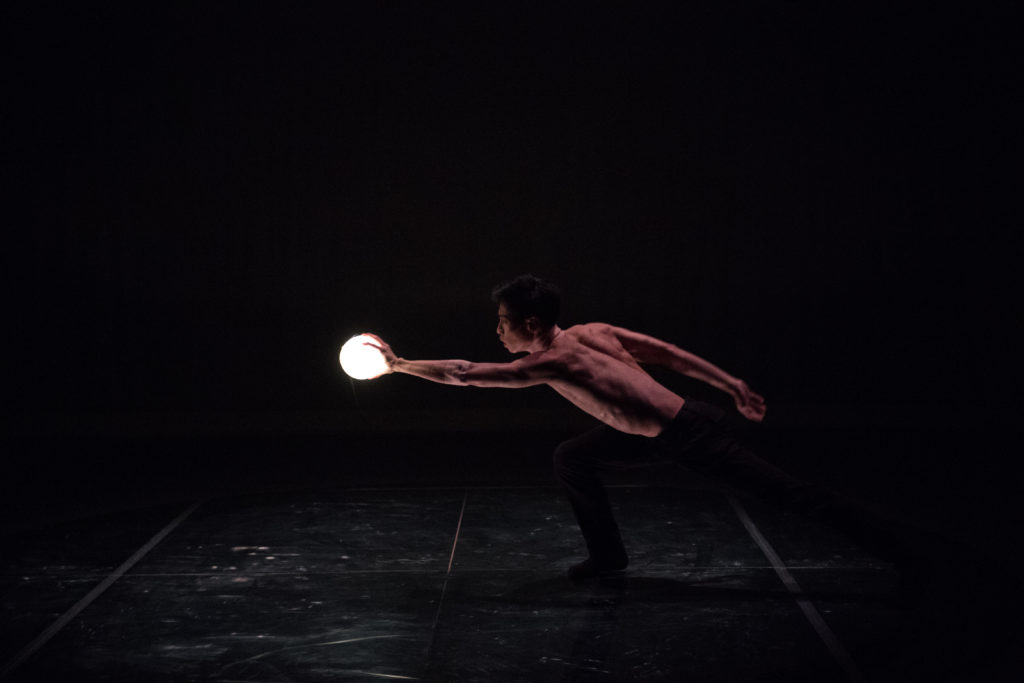
When You See Photo Credit: Conrad Dy-Liacco
There is always a myth about experimentation that it does not need a strong structure. Just a simple creation by breaking the form and see the result with that. Yes, part of it is correct, but to me, that is only plausible when the experimentation is still in a workshop process. Putting Hong Kong Cool as one of the programs in this season of Hong Kong Ballet requires the results of the experimentations, i.e the crossovers to be much more elaborate. These pieces do not need to be full-length pieces, but they need to be completed as artworks without spoiling the hypothesis of putting two art mediums on stage as “total works.” They should be innovative by integrating the two mediums with thoughts and finding the common language between the two. This is the most challenging thing for artists to achieve in experiments.
Only two pieces in Hong Kong Cool are doing that, which are When You See by Ricky Hu and my personal favorite of the night, Monolith by Jonathan Spigner. I was fortunate to see a preview of When You See back in June during the Ballet Symposium held by the company, and I was impressed by the thought of the experimentation in the piece. We were in a pitch black room where one can only see the light of a moon-shaped ball. Music by Oliver Cong begins, and the ball starts to move due to the fact that the ball is hung as a necklace around a dancer’s neck. No one can see the silhouette of the dancer, thus one can only imagine the dancing movements by seeing the movements of the lit ball. I thought this is absolutely the right direction of an experiment, to see how we as audience perceiving dance without seeing the dancer. If the dancer is actually the “moon,” then what kind of feeling does it exude, with the music that is quite intact with the piece.
Three months later, I saw the augmented piece based on that experiment. It is a much more elaborate piece with the music and the choreography that does have a structure. The hypothesis is still the same, to show movements through the “moon” without showing the dancer clearly. It does exude a liberating feeling, but not totally. The main reason is that, unlike those back in the preview in June, the audience is able to see the silhouette of the dancer this time. The direction of the experiment is right, but the result is already diminished by adding that element. Audience to hard to focus solely on the “moon” by occasionally looking at the dancer. Yet, Will You See is still a good experiment as it really tries to integrate the different mediums into an elaborate work.
As for Monolith, Spigner has outdone his past work not just as a choreographer but a director. Spigner is one of the few dancers in the company that knows the theatre language. Unlike other works in Hong Kong Cool, Monolith has minimal music. A lot of the “music” Spigner uses in the piece are the recordings of speeches and sound-mixed voices. This already is a bold statement of experimentation in ballet: ballet movements can be done without music. Does it work, I think so, though comparing it to similar experimentations by Pina Bausch and Netherland Dance Theatre, there is still room to grow. Yet, the gist is still there.
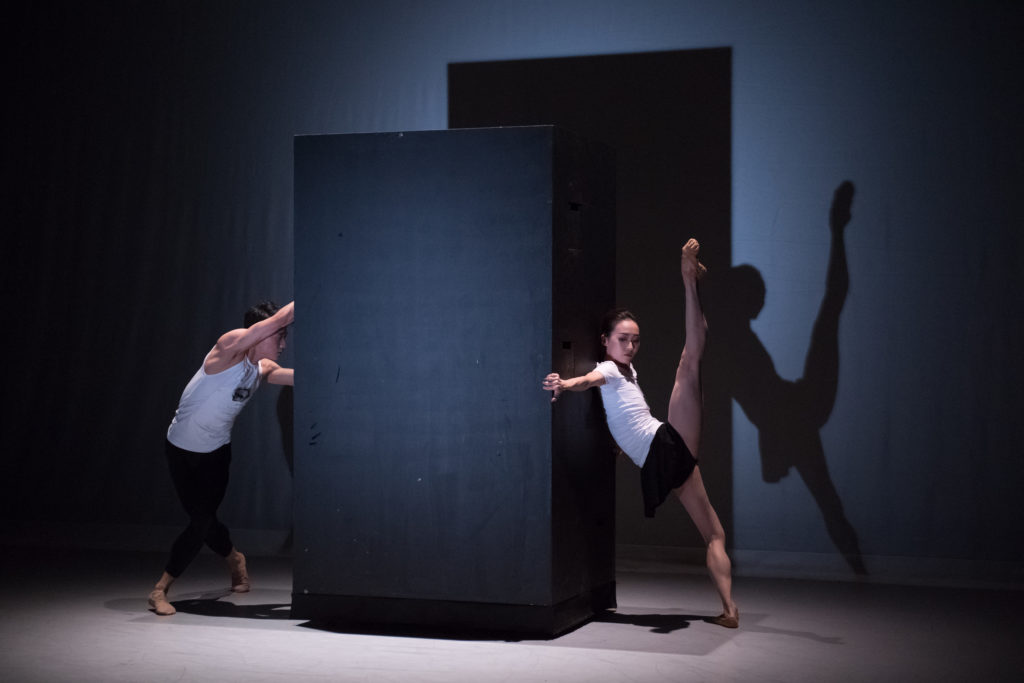
Monolith Photo Credit: Conrad Dy-Liacco
This is already a good start for experimentation, but Spigner does not end there. It is still a crossover piece with visual artist Matthew Tsang whose works focus on the melting and freezing nature of matter like charcoal and ice, and Spigner is totally aware of Tsang’s artworks’ nature. Tsang explores the relationship between the statuses of those matters and time, and Spigner cleverly adapts that theme into his piece. It opens by showing a close-up video of the charcoal melting into liquid form at the back of the stage, while dancers move in front of it with the recording of The Books: You’ll Never Be Alone, a “song” read by a man about time and its relationship with creativity. Such a profound opening of a piece that closely links the theme of the artwork created by Tsang to Spigner’s vision of his choreography. It really grabs my attention as well as to make a clear statement of what this piece is about.
Monolith is a piece in two parts. Once the statement of the piece has been established in the first part with The Books, the second part becomes legit on how Spigner’s choreography and Tsang’s artwork can be integrated as a whole. We see a huge black box resembling the black matter in 2001: A Space Odyssey in the middle of the stage. Two dancers pull out the drawers of the black box and put a small dark piece of charcoal into a transparent bag hung in front of each dancer’s chest. They start to dance along the black box. The “music” (speeches) talks about different kinds of relationship in society, and with that, more and more dancers come out and put the charcoal in their bags in front of their chest. They dance along the “music,” showing movements that are about intimacy but also about isolation at the same time. Their hands join together during a formation, but they are not in sync, somehow suggesting a relationship between these people that is so cosmopolitan. Along the piece, the pieces of charcoal in front of the dancers’ chests slowly become visible as they change their statuses from solid to liquid. They become larger and larger, signifying the passing time.
It is a no-brainer that this piece is about one’s relationship and one’s goal in a city while witnessing time literarily passes in front of us. From there, I know Spigner has put a lot of thought into the crossover, how Tsang’s artwork can speak its theme through ballet while the ballet itself is having its own experimentation. Not to mention the outcome gives both Tsang and Spigner a different reading on themes and messages in their own work. Is it a theme that is totally new? Not exactly, but I dare to say that, the method of presentation is rare. That is the whole point why artists do crossovers. It is all about integrations and adaptations.
Hong Kong Cool by Hong Kong Ballet
Co-Produced with West Kowloon Cultural District & Hong Kong Art School
Studio Theatre, Hong Kong Cultural Centre
Closed on September 16, 2018
This post was written by the author in their personal capacity.The opinions expressed in this article are the author’s own and do not reflect the view of The Theatre Times, their staff or collaborators.
This post was written by Clement Lee.
The views expressed here belong to the author and do not necessarily reflect our views and opinions.

